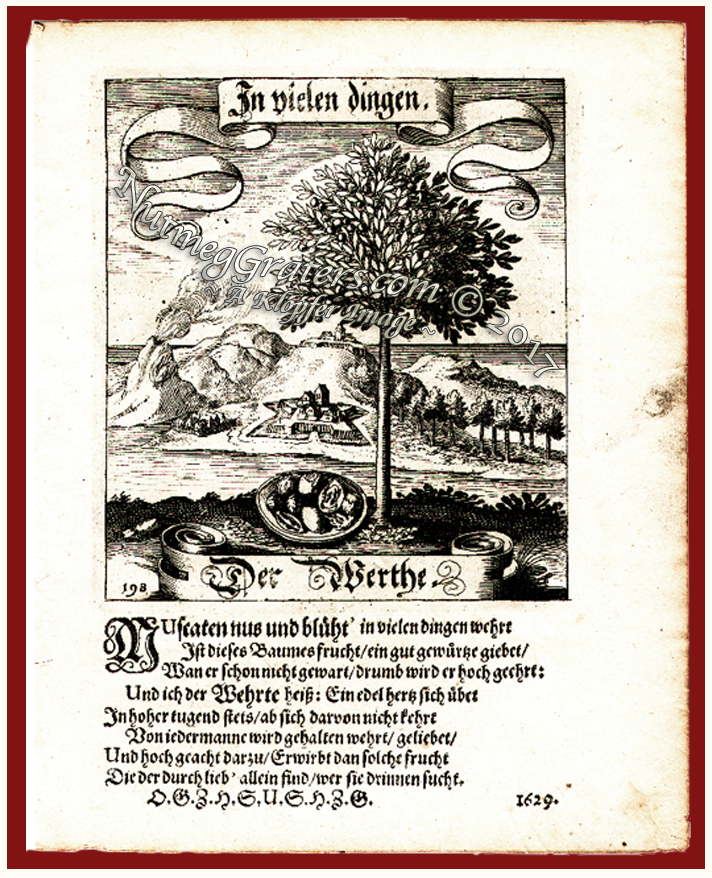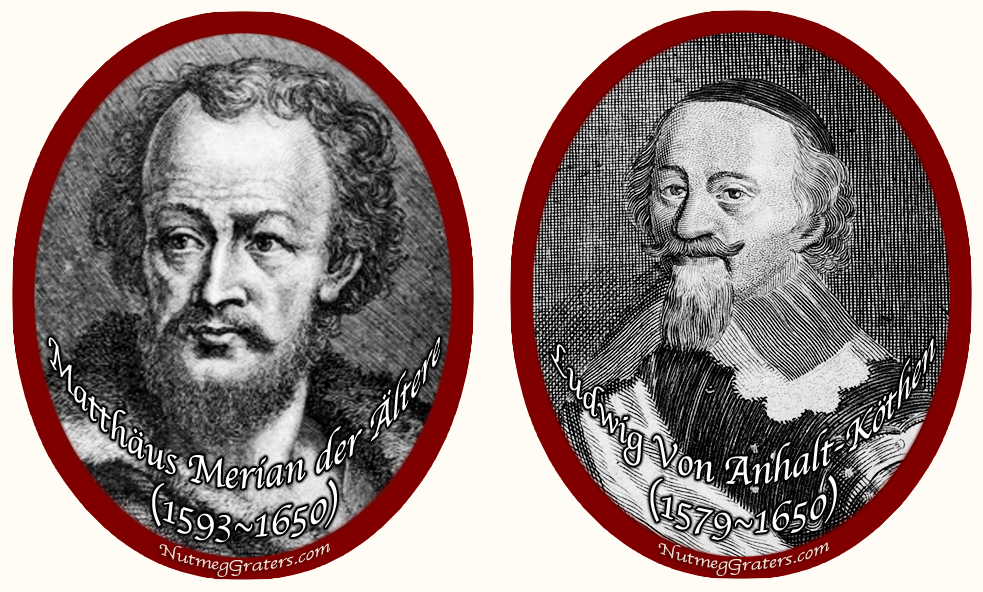NutmegGraters.Com


"In Vielen Dingen Der Werthe"
~1646 ~ Merian ~ Ludwig~
Der Fruchtbringenden Gesellschaft Nahmen, Vorhaben, Gemählde und Wörter: Nach jedes Einnahme ordentlich in Kupfer gestochen, und in achtzeilige Reimgesetze verfasset
PRINT ENTITLED: "In Vielen Dingen Der Werthe" [Direct Translation: "The Many Ways Of Equal Values"; or better: "Eye to eye in most things."].
SOURCE: Der Fruchtbringenden Gesellschaft Nahmen, Vorhaben, Gemählde und Wörter: Nach jedes Einnahme ordentlich in Kupfer gestochen,
und in achtzeilige Reimgesetze verfasset.
[Translation: The fruitfulness of plantings - Names / Projects / Paintings and words: After every take, properly engraved in copper / and written in
eight-line rhyming laws / the first hundred.]
AUTHOR: Ludwig Von Anhalt-Köthen [Ludwig I, Prince of Anhalt-Köthen] .
ENGRAVER: Matthäus Merian der Ältere [Matthew Meriam Sr].
PUBLISHED: Frankfurt, Germany.
DATE OF PUBLICATION: 1646.
PLATE CODE NUMBER: "D.E.Z.H.S.U.S.H.Z.E. 1629".
MEMBER NUMBER: 198.
SCOPE AND PURPOSE OF PUBLICATION: Each page of this publication represents a specific German scholar, linguist, philologist or notable in a
secret society, symbolically depicting each member using a key-phrase (banner), a symbolic plant, a panoramic view and an emblematic rhyme.
PRINT METHOD: Copperplate engraving; a plate mark identifying the intaglio process.
PAPER TYPE: Handmade antique laid and chain ~ link paper; water marked.
HISTORY:
A German organization founded in 1617, Der Fruchtbringenden Gesellschaft [Direct Translation: "The fruitfulness of plantings"; or better known as the "Fruit-Bearing Society"] was an association, who's purpose was to safeguard and retain high standards in quality concerning Germany's national linguistic and literary heritage. Organized by Ludwig I, Prince of Anhalt-Köthen (1579~1650), Der Fruchtbringenden Gesellschaft was the country's first German language club, and maintained a membership of princes, noblemen, poets, scholars, ministers and military elite (totaling 527 individuals across the group's duration from 1617 to 1650).
Under the direction of Ludwig I, between 1646 to 1649 the organization published a four volume text entitled: Der Fruchtbringenden Gesellschaft Nahmen, Vorhaben, Gemählde und Wörter: Nach jedes Einnahme ordentlich in Kupfer gestochen, und in achtzeilige Reimgesetze verfasset. [Translated: The fruitfulness of plantings - Names / Projects / Paintings and words: After every take, properly engraved in copper / and written in eight-line rhyming laws / the first hundred.]
Each of its four volumes contained 100 engraved prints, and every page represented "incognito" a specific group member of the Der Fruchtbringenden Gesellschaft. The famous engraver, Matthäus Merian der Ältere created these 400 copper plates at his atelier in Frankfort, Germany. Each member was designated an individualized engraving containing (1). an emblematic "ornamentally illustrated" plant in the foreground, with (2). a corresponding landscaped background (a panorama, chapel or village view; a botanical or herb garden; an espalier, orchard, or forest; etc.); (3). an "epigram" caption within a banner to serve as the member's identifying alias; (4). the "number" indicating the member's order of admission into the organization; 5). the member's date of admission; (6). an "eight line" poetic stanza; and (7). a set of upper cased letters to signify each member using an anonymous "lettering identification code".
Shown above, "the nutmeg print" was published within the first of this four volume series, being among "the first hundred" engravings (as indicated on the title page). It is a masterpiece in detail: the landscape is illustrated using highly accurate, factual details associated with the actual location depicted ~ an extraordinary fact pertaining to a 1646 engraving. The image shows the Banda Islands. The viewer is situated on the the Isle of Lonthoir, gazinging northward across the Pass of Lonthoir toward the volcanic island Goenoeng Api and the main settlement island of Neira. Also significant is the literary artfulness found both with the epigram and in the eight-line poetic stanza. Masterfully written in "Black-letter" font of the period, this print is an exquisite work of art; both in imagery and in poetry.
Although the member for whom "the nutmeg print" was created remains unknown, he was certainly of significant importance; in 1646, nutmeg was valued at a level where European nations fought wars to possess it and to be associated with this spice was clearly a meaningful honor. For the readers convenience, the important elements within this engraving are summarized below:
| INTERPRETING THE ELEMENTS WITHIN THIS PRINT:
(1). MEMBER'S EMBLEMATIC PLANT: "The Nutmeg Tree" grows near a bowl containing harvested "Nutmeg" retaining its "Mace".
|
Ludwig I, Prince of Anhalt-Köthen (June 17, 1579~January 7, 1650) was a German prince of the House of Ascania who in 1603, became the ruler of Anhalt-Köthen. Early seventeenth century Germany was burdened with much turmoil and dissension among its leadership. Instead of military and political power, Ludwig I ruled using educational and agrarian initiatives. Ludwig's sister, Dorothea Maria of Anhalt died suddenly in August 1617 after a horse riding injury and in her memory, Der Fruchtbringenden Gesellschaf {"Fruit-Bearing Society"} was created with her younger brother Ludwig I becoming its leader, a position he maintained throughout his entire life. It was Ludwig I who initiated each member into the organization, personally awarding each new member with the society's insignia, and with a medallion hung around the neck. Through this refined and aristocratic initiative, Ludwig I brilliantly unified Germany's national spirit and pride.
Matthäus Merian der Ältere (September 22, 1593~June 19, 1650) was a world prominent and highly accomplished engraver, geographer, alchemical illustrator and publisher of the seventeenth century. He is best known for his achievement in engraving cityscapes and landscapes, scientific illustrations, and topographia prints. Born in Basel, Switzerland, at age 16, Matthäus was apprenticed in Zurich to the painter and engraver Dietrich Meyer. He studied in Nancy, Stuttgart, Paris and elsewhere before coming to Frankfort, Germany, where in 1617, Matthäus married Maria Magdalena de Bry, daughter of the engraver, publisher and bookseller J. T. de Bry. Briefly working with his father-in-law, Matthäus returned to Basel until de Bry's death in 1623, when Matthäus inherited control of the de Bry's publishing and bookseller business. He returned to Frankfort, becoming a citizen which allowed him to become an independent publisher in that city. Both the volume and the quality of Matthäus work in Frankfort is astonishing. Unfortunately, he suffered a long standing illness leading to his death in 1650, after which the business was continued by his sons Matthäus Jr. and Caspar.
[KLOPFER article © May 2017]
